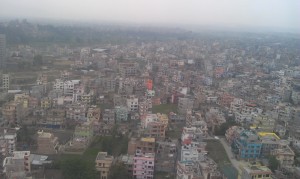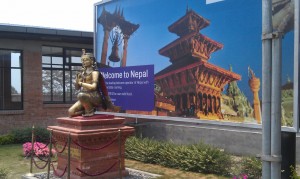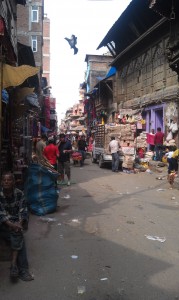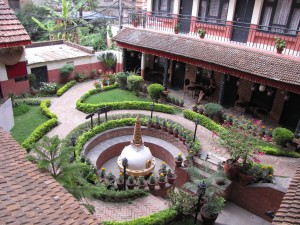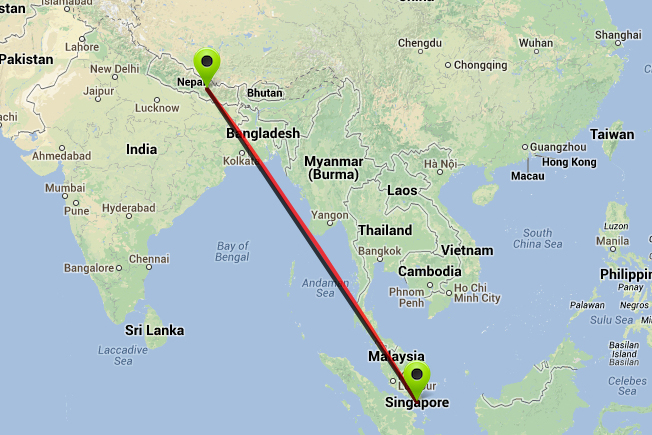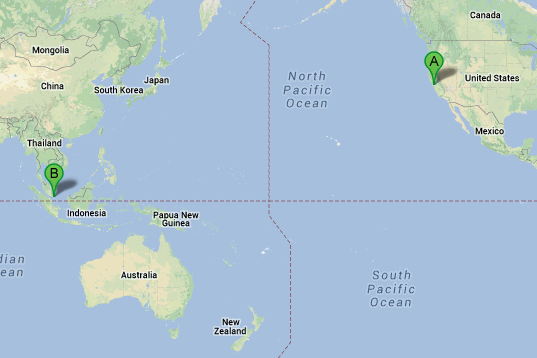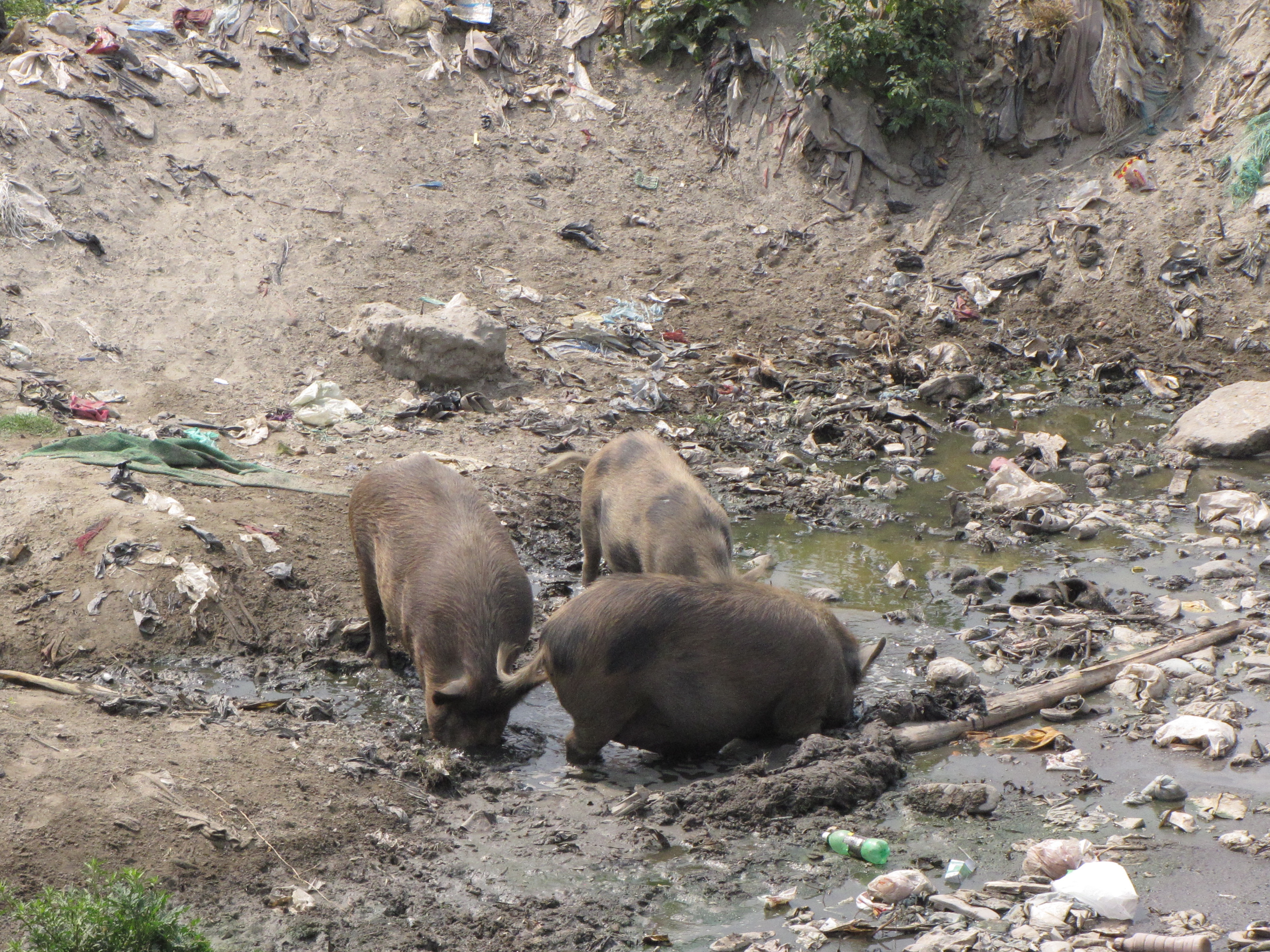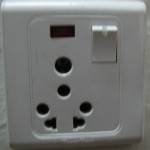The time to board the five-hour domestic flight to Kathmandu had finally arrived. I went through security for the third time and had another uneventful flight. We began by soaring over the stunning green landscape and turquoise oceans of Malaysia. Soon after the water took on a brown, barren appearance that at first I took to be a desert. It’s only when we crossed onto land again that I realized it was water. The land appeared equally inhospitable. Where are we? The in-flight monitor was no help. Instead of the “you are here” flight path we enjoyed on the international flight, we were stuck with a cheesy Asian talent show involving sock puppets and reruns of Wipeout.
We crossed over huge brown rivers, or maybe they were they dry river beds. Eventually the land sloped upward and the pilot announced our approach. I looked hopefully across the sea of brown haze for a mountain peak and realized I must be on the wrong side of the plane. From Singapore, you want the right side of the plane to view the Himalayas and I was on the left.
Flying over Kathmandu, I was surprised at how big and colorful the city was. I’d had fair warning that it would feel third world and indeed the lower we flew the more apparent the crumbling buildings and scattered trash became.
We landed and used a ladder to deplane. A bus picked us up and we drove a short distance to customs. The building was old and beautiful with brick masonry and carved wood. I followed the crowd to a big room with various wooden kiosks littered with paper.
Okay now what? I overheard a man with a British accent loudly and bossily giving directions to a group of old ladies as to which lines on the form they needed to fill out and which ones the Nepali customs people didn’t care about. I chose a kiosk within eavesdropping range and followed his directions to fill out a Visa application (the big form) in addition to the card from the flight. But the anal accountant in me filled out all the lines. There were no writing utensils. I didn’t pack a pen and made do with my pencil.
I followed them to a line behind a desk with a row of four Nepalese men. When I reached the front, the first man checked the length of my stay, collected the $40 entry fee, and gave me two receipts. Next I handed the pink copy of the receipt to one of two men who were checking forms and passports. Finally I proceeded to the last man who issued the Visa, which was a sticker rather than a stamp.
From here I proceeded to the baggage claim. By this point I was tired, but perked up the instant I glimpsed my bag disappearing back to the employee-only side of the carriage. It made it! I almost skipped to the other side of the belt to await its reappearance and immediately stuffed all the coats I had been carrying with me “just in case” inside.
They waved me through customs and I braced myself for the chaos that awaited outside the airport. Active had sent multiple warning emails before our departure about arrival in Kathmandu. Forget altitude. Forget base camp. Apparently our most difficult challenge would be getting from the airport to the hotel.
I carried my own bag as instructed and found a man outside holding the Active Himalayas sign without any trouble. I then proceeded to walk the wrong way around a fence and was shooed in the other direction by airport security.
The man escorted me to and then left me at a van as he went in search of another passenger. Not long afterward he reappeared with a girl who introduced herself as Amanda.
Next we got our first taste of what we were warned of repeatedly before arriving. A man rushed up to the van and shouted aggressively that we must leave a tip and US dollars were OK.
Amanda told him “no” but he persisted.
She then shouted “we’re with him!” and pointed to our driver who was ignoring the whole scene as he calmly got in the van and closed the driver’s side door.
At this, the man melted back in to the madness and we were on our way. Amanda was originally from Wales and exclaimed in her lovely British accent how intense that was. I told her she did great, especially since all I could offer while it was going down was a mute wide-eyed stare and a mouth slightly ajar.
We began the navigation through the narrow, dusty streets of the city. The closest I’d ever experienced to this before was in Mexico, but even that could not compare. It was order within disorder. Totally organic. No traffic laws, signs, lights or lanes. People, bicycles, motorcycles, cars, weird tractor car looking things, rickshaws… You name it, it was on the road and traveling wherever there was space to move forward. I was reminded of science movies featuring magnified blood cells all squeezing by each other, except blood cells tend to move in one direction.
I was amazed at how well our driver navigated our relatively large vehicle through the bedlam right down to the point where he made a three-point turn in the middle of a crowded narrow street and backed into an even narrower crowded alley in front of our hotel with maybe a few feet to spare on either side of the van.
We checked in to the beautiful Thamel Eco Resort and received a note from our trip leader DK instructing us on where and what time to meet. My future roommate had already arrived, had the only key, and was not there. I waited outside the room until an employee let me in and checked the clock… my clock since there wasn’t one in the room. It had been 40 hours of travel since I left my house in California. Nap time. I collapsed on my bed, so grateful to be horizontal.
The rest of the afternoon was something of a blur. I met my roommate Dovile, a spunky and pretty blonde from Chicago who woke me up in time for our orientation with the whole group.
“This is my first backpacking trip,” she told me.
“What?” I laughed, somewhat incredulously. “If Everest is where you start, what are you going to do next?”
We walked upstairs to a yoga studio on the top floor of the hotel, and pulled some chairs in a circle. Including Dovile and I, there were 8 guests and two main guides (a third guide, Bibak, would join us on the mountain). Kevin and Stacy, a beautiful couple from Aspen. Mike and Sara, friends who just finished grad school in Colorado and were embarking on a world tour before starting work. Amanda and Ele who worked for Active in New Zealand.
Our trip leaders were DK and Sudip. Both of them, but especially DK, had that “smell.” The smell of someone who’s ridden the back of the wind, of 100 fun summers, of sleeping in trees, and adventures with Indians and pirates. (Hook, 1991). They were good-looking and had the sort of charisma that made people want to be around them. This adventure was going to be a fun one.
The trip was organized by Active Adventures in partnership with Earthbound Expeditions. I’d traveled with Active before in New Zealand on one of their Rimu trips and couldn’t have been happier with the experience so they were easily my first pick to see the Himalayas. Our goal was Everest Base Camp, and we’d be together 19 days for the journey there and back.
The guides gave us each goodie bags full of fun stuff like water purification tablets, hand sanitizer, and toilet paper. I joke, but all these things were practically worth their weight in gold on the trail. Each pair of roommates received a porter bag to share with a potato sack to separate each person’s belongings. Each porter bag had a different colored prayer flag to identify it. People who rented sleeping bags received one of these with a prayer flag to identify it too, in case it needed to be moved to another bag for weight distribution reasons.
Later we went to dinner on a rooftop with a starlit view of the Monkey Temple. Insanely cool place. DK told us the meat was okay to eat here, but I was looking forward to jumping right in to the Nepali cuisine experience after reading about my friend Katie’s experiences on her earlier Annapurna trek. I ordered my first dal bhat with ginger tea. Dal is lentil soup, bhat is rice, and it also usually comes with some sort of vegetable curry. I proceeded to start eating the dal with a spoon and DK tried to steer me in the right direction. In his gentle and polite Kiwi way, he told me the dal was supposed to go on the rice. I poured a little bit on, but still wouldn’t get the right idea until I saw the locals do it later. Even then I never mustered up the courage to eat it with my fingers.
We began to get to know each other better. Somehow I mentioned I’m from the Mojave desert and people asked me if we really have snakes and scorpions. Yes, we really have snakes and scorpions. Funny how something so ordinary to you can be so fascinating to others. Ele, Amanda and I realized we knew a couple of the same people through Active. Ele told me about a Nepali translator app she downloaded and I was immediately super-jealous of it. We’d hear the language all day on the trail, but I knew it wouldn’t sink in for me until I also saw it in print. The app really would have helped. Even without the benefit of alcohol (in most cases, see keeping healthy on the trail), the group was warming up to each other and starting to feel like a family.
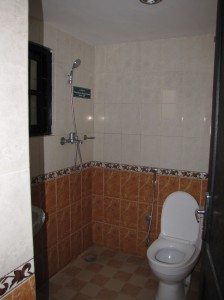 That night was my first adventure with Nepali plumbing. After two days of planes, trains and automobiles
That night was my first adventure with Nepali plumbing. After two days of planes, trains and automobiles I was rather greasy and keen on a shower. The entire bathroom was tile and a shower head on a long hose was simply attached to a wall. I turned it on and it proceeded to drench the toilet seat and the spare toilet paper on top.
I closed the lid, found higher ground for the TP, and engaged in a wrestling match with the hose, since more water was pouring out of it than the actual shower head. We settled on a compromise where I looped the hose in such a way that the water poured straight down and held it over my head, trying with some success not to get it in my mouth or eyes.
The entire bathroom was now a lake. Neither of us had packed thongs/flip-flops/jandals and made it our mission to find some ASAP.
I was still on California time and wide awake even though it was after 11 pm so I begin reading The Snow Leopard. I’d read a few other famous Himalaya-related books already and was saving this one. It had been highly recommended to me the year before by a friend whose opinion I respect, and I was happy to finally open it up.

